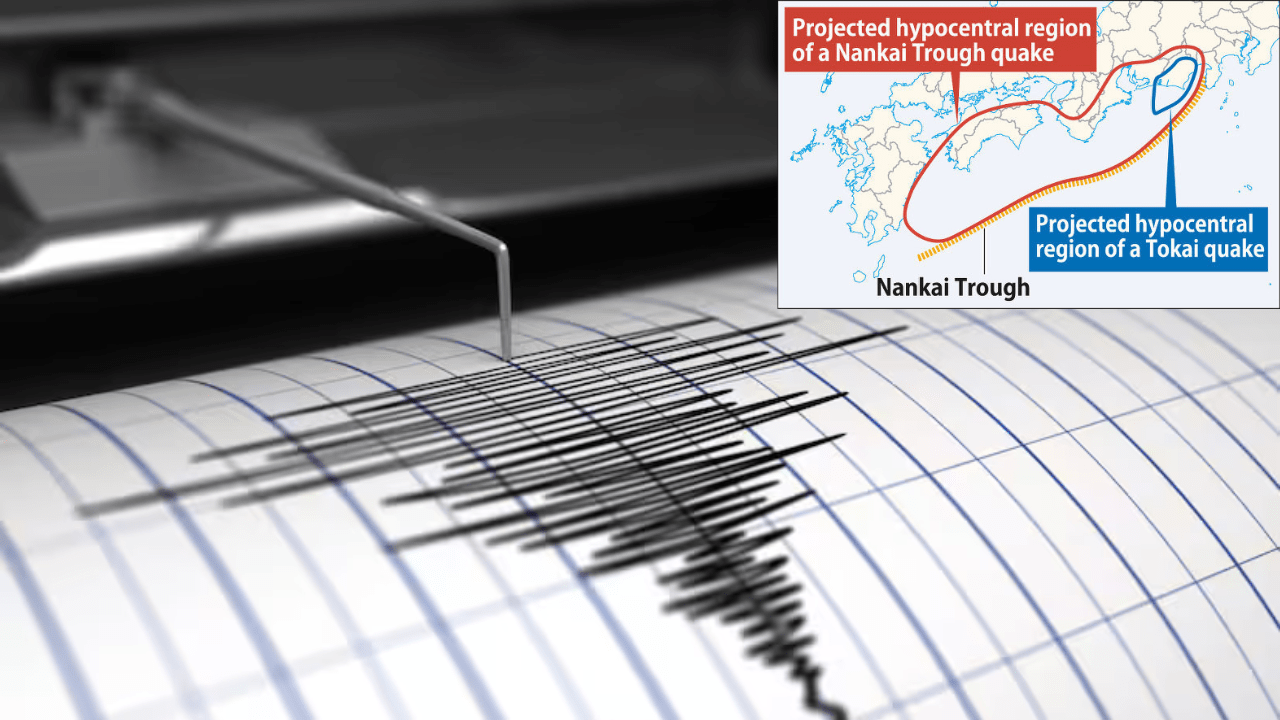Earthquake of 6.3 Magnitude Jolted Western Japan, Sending Tremors Through Communities; Authorities Breathe Sigh of Relief as Tsunami Warning Stay Silent, But Vigilance Persists!

On Wednesday night, Tokyo and its surrounding regions experienced a tremor as a 6.3 magnitude earthquake struck off the southwestern coast of Japan. The United States Geological Survey (USGS) provided initial data on the seismic event, situating its epicenter in a channel between the islands of Kyushu and Shikoku, approximately 18 kilometers (11 miles) west of Uwajima. The quake occurred at a depth of approximately 25 kilometers.
Despite the significant magnitude, no tsunami warnings were issued, and reports indicated minimal damage and no immediate threats to the safety of residents. Fortunately, there were no reports of substantial injuries or fatalities resulting from the earthquake.
The impact was felt most notably in the Ehime Prefecture town of Ainan and the Kochi Prefecture city of Sukumo, where the quake registered a magnitude of 6 on the intensity scale, denoting a moderate level of shaking. The quake’s epicenter was identified within the Bungo Channel, a vital waterway that separates Kyushu and Shikoku.
In the aftermath of the earthquake, authorities reported nine individuals sustaining light injuries across Ehime, Kochi, and Oita prefectures. While minor damages were observed in certain areas, including broken water pipes, fallen streetlights, and a localized landslide on a national roadway, there were no reports of widespread destruction or fires.
Efforts are underway to assess and address any further repercussions of the earthquake, with authorities closely monitoring the situation and providing necessary assistance to affected communities. Despite the unsettling occurrence, the prompt response and resilience of the region underscore Japan’s preparedness and expertise in managing seismic events.
6.3 Magnitude Earthquake Rocks Western Japan, Residents Brace for Impact; Tsunami Warning Averted
Following the earthquake in southwestern Japan, additional details have emerged regarding its impact and ongoing monitoring efforts:
A woman in her 70s from Ainan was hospitalized after collapsing due to injuries sustained during the earthquake, as reported by the local fire department. This underscores the importance of prioritizing the well-being of individuals affected by such natural disasters.
Shikoku Electric Power’s Ikata nuclear power plant in Ehime Prefecture has been declared free of abnormalities by the Nuclear Regulation Authority. This assurance helps alleviate concerns regarding potential nuclear-related risks resulting from the seismic activity.
Initially reported as a magnitude 6.4 event by the Meteorological Agency, the earthquake’s magnitude was later revised to 6.6. Satoshi Harada, head of the agency’s earthquake and tsunami monitoring division, clarified that while the magnitude falls below the threshold requiring investigation into its relation with the Nankai Trough earthquake, ongoing monitoring and updates will be provided as necessary.
Harada emphasized the continued heightened seismic activity following the earthquake, urging residents in affected areas to remain vigilant. The agency has issued advisories regarding the potential risks of further seismic activity and heavy rainfall in the coming week, highlighting the increased likelihood of house collapses and landslides in areas where the tremors were particularly intense.
The occurrence of this earthquake has reignited concerns about the possibility of a larger Nankai Trough earthquake, which historically transpires every 100-150 years. With the last event transpiring 70 years ago, there’s a palpable sense of apprehension regarding the potential for a seismic event of significant magnitude in the region.
The Nankai Trough, is a simmering cauldron of geological tension stretching from the Tokai region to offshore eastern Kyushu. Here, beneath the serene surface of the ocean, a dramatic dance unfolds as the oceanic plate dives beneath its continental counterpart, silently accumulating strain along the boundary. It’s a geological powder keg, primed to explode when the accumulated tension is finally unleashed.
During the recent conference, Satoshi Harada captivated the audience with his insights into the seismic intricacies of the region. He revealed that the earthquake’s origins lie not at the surface, where the two plates meet, but deeper within the bowels of the Earth. It’s a reminder of the hidden forces at play beneath our feet, shaping the very landscape we tread upon. Yet, amidst the intrigue, uncertainty looms like a shadow. Harada’s admission that the earthquake’s occurrence hasn’t tipped the scales definitively toward or away from a Nankai Trough earthquake leaves the audience on edge. It’s a reminder of nature’s enigmatic ways, keeping us guessing even as we strive to unravel its mysteries.
As the conference drew to a close, one thing was clear: the journey to understanding and predicting seismic activity in the Nankai Trough is far from over. With each revelation, each tremor, the quest for knowledge continues. And with it, the hope of better preparing ourselves for the seismic challenges that lie ahead.
As Japan remains on alert and communities continue to recover from the recent earthquake, efforts to monitor seismic activity and enhance preparedness measures are paramount in ensuring the safety and resilience of the affected regions.
Read More:

The Psychology of Love: Why Valentines Day Matters More Epic Than You Think
Discover the psychology of love and why Valentines Day is more important than you think. Learn how love impacts the brain, strengthens relationships, and boosts

Premier League Highlights: Arsenal Humiliate Man City 5-1, Spurs and Palace Secure Crucial Wins
Arsenal demolished Manchester City 5-1 in a statement premier league highlights win, reigniting their title hopes. Meanwhile, Crystal Palace stunned Man United 2-0, and Tottenham

How Budget 2025 Impacts the Indian Middle-Class: Major Tax Benefits and Glaring Omissions
Budget 2025 offers major tax relief to the middle class, including zero tax on incomes up to ₹12 lakh. However, it misses out on incentives

Degrees vs Employability: Why “Highly Qualified Degree Holders” Struggle to Find Jobs While “Less Qualified Individuals” Get Hired Faster!
Many highly qualified individuals struggle to secure jobs, while less qualified candidates get hired quickly. This Degrees vs Employability paradox is caused by employer preferences,

The Power of Mindset: Why Looking Poor Doesn’t Make You Poor, but Thinking Poor Does!
Discover why looking poor doesn’t define your wealth but thinking poor does. Learn the power of mindset and how a growth-oriented mindset can lead to

Overthinking: How It’s Damaging Today’s Youth – Causes and Cure in 2025
Understanding how overthinking is silently damaging today’s youth, from its causes rooted in societal pressure and social media to its long-term effects on mental health.
